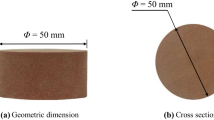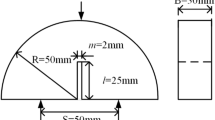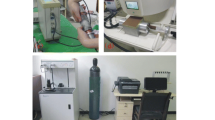Abstract
Understanding the characteristics of rock hardness variation under different temperature paths is of great significance to expand the deep rock-breaking capacity. In this study, high temperature treatments with four temperature paths of slow heating–natural cooling (S–S), fast heating–natural cooling (F–S), slow heating–water cooling (S–F), and fast heating–water cooling (F–F) were conducted on sandstone specimens in the temperature range of 25–900 °C. Leeb hardness and indentation hardness tests were conducted on the rocks after heat treatment, and the influence of temperature paths on rock hardness and its mechanism was studied and discussed. In addition, chromaticity and wave velocity tests were conducted to analyze the correlation between the hardness of thermally-damaged rock and chromaticity and P-wave velocity. The results showed that, with increasing temperature, the Leeb hardness and indentation hardness of sandstone under S–S and F–S paths increased first (25–300 °C), then decreased (300–700 °C) and then increased (700–900 °C), while the Leeb hardness and indentation hardness under S–F and F–F paths decreased gradually. For natural cooling treatment, sandstone hardness under F–S path was slightly higher than that under S–S path before 500 °C, and under S–S path it was higher when the temperature reached 500 °C and hotter. Compared to natural cooling, water cooling resulted in more severe damage to the heat-treated sandstone, manifested in lower hardness values. Combined with scanning electron microscopy, it was found that different degrees of crack propagation caused by thermal stress generated by the temperature gradient in rocks under different temperature paths was the main reason for different degrees of rock damage. There was no significant correlation between rock chromaticity and hardness parameters, while a good linear correlation was shown between P-wave wave velocity and hardness parameters, indicating that the hardness of thermally-damaged rocks can be predicted by P-wave velocity to some extent.













Similar content being viewed by others
References
Barbier, E. (2002). Geothermal energy technology and current status: An overview. Renewable & Sustainable Energy Reviews, 6(1–2), 3–65.
Beentjes, I., Bender, J. T., Hawkins, A. J., & Tester, J. W. (2020). Chemical dissolution drilling of barre granite using a sodium hydroxide enhanced supercritical water jet. Rock Mechanics and Rock Engineering, 53(2), 483–496.
Blackwell, D. D., & Steele, J. L. (1981). Heat flow and geothermal potential of Kansas. NASA STI/Recon Technical Report N.
Collin, M., & Rowcliffe, D. (2000). Analysis and prediction of thermal shock in brittle materials. Acta Materialia, 48(8), 1655–1665.
Corkum, A. G., Asiri, Y., El Naggar, H., & Kinakin, D. (2018). The Leeb hardness test for rock: An updated methodology and UCS correlation. Rock Mechanics and Rock Engineering, 51(3), 665–675.
Dai, X. W., Huang, Z. W., Wu, X. G., Shi, H. Z., & Xiong, C. (2021). Failure analysis of high-temperature granite under the joint action of cutting and liquid nitrogen jet impingement. Rock Mechanics and Rock Engineering, 54(12), 6249–6264.
Deng, L., Li, X., Wu, Y., Li, F., Huang, Z., Ji, Y., Zou, C., & Liu, Z. (2022). Influence of cooling speed on the physical and mechanical properties of granite in geothermal-related engineering. Deep Underground Science and Engineering, 1(1), 40–57. https://doi.org/10.1002/dug2.12011
Deyab, S. M., Rafezi, H., Hassani, F., Kermani, M., & Sasmito, A. P. (2021). Experimental investigation on the effects of microwave irradiation on kimberlite and granite rocks. Journal of Rock Mechanics and Geotechnical Engineering, 13(2), 267–274.
Ding, Q. L., Ju, F., Mao, X. B., Ma, D., Yu, B. Y., & Song, S. B. (2016). Experimental investigation of the mechanical behavior in unloading conditions of sandstone after high-temperature treatment. Rock Mechanics and Rock Engineering, 49(7), 2641–2653.
Dong, Z., Sun, Q., & Ranjith, P. G. (2019). Surface properties of grayish-yellow sandstone after thermal shock. Environmental Earth Sciences, 78(14), 420.
Fan, L., Li, H., & Xi, Y. (2022). Evaluation of the effects of three different cooling methods on the dynamic mechanical properties of thermal-treated sandstone. Bulletin of Engineering Geology and the Environment, 81(4), 154.
Feng, J. Y., Yan, T., Cao, Y., & Sun, S. H. (2022). Ultrasonic-assisted rock-breaking technology and oil and gas drilling applications: A review. Energies, 15(22), 8394.
Gao, M. Z., Yang, B. G., Xie, J., Ye, S. Q., Liu, J. J., Liu, Y. T., Tang, R. F., Hao, H. C., Wang, X., Wen, X. Y., & Zhou, X. M. (2022). The mechanism of microwave rock breaking and its potential application to rock-breaking technology in drilling. Petroleum Science, 19(3), 1110–1124.
Garrido, M. E., Petnga, F. B., Martínez-Ibáñez, V., Serón, J. B., Hidalgo-Signes, C., & Tomás, R. (2022). Predicting the uniaxial compressive strength of a limestone exposed to high temperatures by point load and Leeb rebound hardness testing. Rock Mechanics and Rock Engineering, 55(1), 1–17.
Gautam, P. K., Verma, A. K., Jha, M. K., Sharma, P., & Singh, T. N. (2018). Effect of high temperature on physical and mechanical properties of Jalore granite. Journal of Applied Geophysics, 159, 460–474.
Ge, Z. L., Sun, Q., & Li, W. P. (2018). Temperature and pressure effect on permeability of Chinese sandstone: A review. Acta Geodynamica et Geomaterialia, 15(3), 289–296.
Ge, Z., & Sun, Q. (2021). Acoustic emission characteristics of gabbro after microwave heating. International Journal of Rock Mechanics and Mining Sciences, 138, 104616.
Ghorbani, S., Hoseinie, S. H., Ghasemi, E., Sherizadeh, T., & Wanhainen, C. (2022). A new rock hardness classification system based on portable dynamic testing. Bulletin of Engineering Geology and the Environment, 81(5), 179.
Guo, X., Zou, G. F., Wang, Y. H., Wang, Y., & Gao, T. (2017). Investigation of the temperature effect on rock permeability sensitivity. Journal of Petroleum Science and Engineering, 156, 616–622.
Guo, C., Sun, Y., Yue, H., Li, Q., He, S., Zhang, J., & Zhang, Y. (2022). Experimental research on laser thermal rock breaking and optimization of the process parameters. International Journal of Rock Mechanics and Mining Sciences, 160, 105251.
Hoseinie, S. H., Ataei, M., & Mikaiel, R. (2012). Comparison of some rock hardness scales applied in drillability studies. Arabian Journal for Science and Engineering, 37(5), 1451–1458.
Hu, X., Song, X., Li, G., Shen, Z., Lyu, Z., Shi, Y., & Zheng, R. (2018). An analytical model to evaluate the heating conditions for drilling in hard rock using an innovative hydrothermal spallation method. Applied Thermal Engineering, 142, 709–716.
Huang, Z. W., Wu, X. G., Li, R., Zhang, S. K., & Yang, R. Y. (2019). Mechanism of drilling rate improvement using high-pressure liquid nitrogen jet. Petroleum Exploration and Development, 46(4), 810–818.
Jamali, S., Wittig, V., Borner, J., Bracke, R., & Ostendorf, A. (2019). Application of high powered Laser Technology to alter hard rock properties towards lower strength materials for more efficient drilling, mining, and Geothermal Energy production. Geomechanics for Energy and the Environment, 20, 100112.
Jha, P., Rajguru, S., Parmar, J., & Shah, M. (2023). A holistic study on geothermal and solar water desalination system for sustainable development. Environmental Science and Pollution Research, 30(1), 90–103.
Kahraman, S., Fener, M., & Kozman, E. (2012). Predicting the compressive and tensile strength of rocks from indentation hardness index. Journal of the Southern African Institute of Mining and Metallurgy, 112(5), 331–339.
Kalyan, B., Murthy, C. S., & Choudhary, R. P. (2015). Rock indentation indices as criteria in rock excavation technology–A critical review. Procedia Earth and Planetary Science, 11, 149–158.
Kilic, A., & Teymen, A. (2008). Determination of mechanical properties of rocks using simple methods. Bulletin of Engineering Geology and the Environment, 67(2), 237–244.
Kingery, W. D. (1955). Factors affecting thermal stress resistance of ceramic materials. Journal of the American Ceramic Society, 38(1), 3–15.
Kompanikova, Z., Gomez-Heras, M., Michnova, J., Durmekova, T., & Vlcko, J. (2014). Sandstone alterations triggered by fire-related temperatures. Environmental Earth Sciences, 72(7), 2569–2581.
Li, M., & Lior, N. (2015). Energy analysis for guiding the design of well systems of deep Enhanced Geothermal Systems. Energy, 93, 1173–1188.
Li, N., Ma, X., Zhang, S., Zou, Y., Wu, S., Li, S., Zhang, Z., & Cao, T. (2020a). Thermal Effects on the physical and mechanical properties and fracture initiation of Laizhou granite during hydraulic fracturing. Rock Mechanics and Rock Engineering, 53(6), 2539–2556.
Li, Q., Yin, T., Li, X., & Zhang, S. (2020b). Effects of rapid cooling treatment on heated sandstone: A comparison between water and liquid nitrogen cooling. Bulletin of Engineering Geology and the Environment, 79(1), 313–327.
Li, N., Zhang, S., Wang, H., Wu, S., Zou, Y., Ma, X., & Zhou, T. (2021). Thermal shock effect on acoustic emission response during laboratory hydraulic fracturing in Laizhou granite. Rock Mechanics and Rock Engineering, 54(9), 4793–4807.
Li, G. S., Wu, X. G., Song, X. Z., Zhou, S. M., Li, M. H., Zhu, H. Y., Kong, Y. L., & Huang, Z. W. (2022a). Status and challenges of hot dry rock geothermal resource exploitation. Petroleum Science Bulletin. https://doi.org/10.2139/ssrn.4424618
Li, X. L., Wu, Y. B., He, L. H., Zhang, X. H., & Wang, J. G. (2022b). Research on dynamic properties of deep marble influenced by high temperature. Mathematics, 10(15), 2603.
Liu, S., & Xu, J. Y. (2015). An experimental study on the physico-mechanical properties of two post-high-temperature rocks. Engineering Geology, 185, 63–70.
Liu, W., Deng, K., Li, R., Li, L., Zhu, X., & Gong, S. (2022). The performance and failure mechanism of drill bit in granite formation drilling. Arabian Journal for Science and Engineering, 48, 9477–9492.
Lu, C., Sun, Q., Zhang, W. Q., Geng, J. S., Qi, Y. M., & Lu, L. L. (2017). The effect of high temperature on tensile strength of sandstone. Applied Thermal Engineering, 111, 573–579.
Lu, G. M., Feng, X. T., Li, Y. H., & Zhang, X. W. (2019). The microwave-induced fracturing of hard rock. Rock Mechanics and Rock Engineering, 52(9), 3017–3032.
Lund, J. W., Huttrer, G. W., & Toth, A. N. (2022). Characteristics and trends in geothermal development and use, 1995 to 2020. Geothermics, 105, 102522.
Mahanta, B., Ranjith, P. G., Vishal, V., & Singh, T. N. (2020). Temperature-induced deformational responses and microstructural alteration of sandstone. Journal of Petroleum Science and Engineering, 192, 107239.
Martinez-Ibanez, V., Garrido, M. E., Signes, C. H., Basco, A., Miranda, T., & Tomas, R. (2021). Thermal effects on the drilling performance of a limestone: Relationships with physical and mechanical properties. Applied Sciences, 11(7), 3286.
Olasolo, P., Juárez, M. C., Morales, M. P., D’Amico, S., & Liarte, I. A. (2016). Enhanced geothermal systems (EGS): A review. Renewable and Sustainable Energy Reviews, 56, 133–144.
Pathiranagei, S. V., Gratchev, I., & Kong, R. (2021). Engineering properties of four different rocks after heat treatment. Geomechanics and Geophysics for Geo-Energy and Geo-Resources, 7(1), 16.
Ranjith, P. G., Viete, D. R., Chen, B. J., & Perera, M. S. A. (2012). Transformation plasticity and the effect of temperature on the mechanical behaviour of Hawkesbury sandstone at atmospheric pressure. Engineering Geology, 151, 120–127.
Rao, Q. H., Wang, Z., Xie, H. F., & Xie, Q. (2007). Experimental study of mechanical properties of sandstone at high temperature. Journal of Central South University of Technology, 14, 478–483.
Rossi, E., Kant, M. A., Madonna, C., Saar, M. O., & von Rohr, P. R. (2018). The effects of high heating rate and high temperature on the rock strength: Feasibility study of a thermally assisted drilling method. Rock Mechanics and Rock Engineering, 51(9), 2957–2964.
Rossi, E., Jamali, S., Schwarz, D., Saar, M. O., & von Rohr, P. R. (2020). Field test of a combined thermo-mechanical drilling technology. Mode II: Flame-assisted rotary drilling. Journal of Petroleum Science and Engineering, 190, 106880.
Samin, M. Y., Faramarzi, A., Jefferson, I., & Harireche, O. (2019). A hybrid optimisation approach to improve long-term performance of enhanced geothermal system (EGS) reservoirs. Renewable Energy, 134, 379–389.
Tian, H., Zhu, Z. N., Ranjith, P. G., Jiang, G. S., & Dou, B. (2021). Experimental investigation of drillability indices of thermal granite after water-cooling treatment. Natural Resources Research, 30(6), 4621–4640.
Wang, F., & Konietzky, H. (2020). Thermal damage evolution of granite under slow and high-speed heating conditions. Computers and Geotechnics, 123, 103590.
Yasar, E., & Erdogan, Y. (2004). Estimation of rock physicomechanical properties using hardness methods. Engineering Geology, 71(3–4), 281–288.
Yang, S. Q., Ranjith, P. G., Jing, H. W., Tian, W. L., & Ju, Y. (2017). An experimental investigation on thermal damage and failure mechanical behavior of granite after exposure to different high temperature treatments. Geothermics, 65, 180–197.
Yavuz, H., Demirdag, S., & Caran, S. (2010). Thermal effect on the physical properties of carbonate rocks. International Journal of Rock Mechanics and Mining Sciences, 47(1), 94–103.
Zhang, W. Q., & Sun, Q. (2018). Identification of primary mineral elements and macroscopic parameters in thermal damage process of limestone with canonical correlation analysis. Rock Mechanics and Rock Engineering, 51(4), 1287–1292.
Zhang, W. Q., Sun, Q., Hao, S. Q., Geng, J. S., & Lv, C. (2016). Experimental study on the variation of physical and mechanical properties of rock after high temperature treatment. Applied Thermal Engineering, 98, 1297–1304.
Zhang, H., Sun, Q., Liu, L., & Ge, Z. (2020). Changes in glossiness, electrical properties and hardness of red sandstone after thermal treatment. Journal of Applied Geophysics, 175, 104005.
Zhang, W., Wang, Z., Shi, Z., Xu, P., & Chang, Z. (2022). Influence mechanism of high temperature on drilling rate and hardness of sandstone. Natural Resources Research, 31(5), 2589–2601.
Zhao, F., & Sun, Q. (2020). Combined effects of cooling rate and salt on physical properties of yellow sandstone collected from Eastern China. Arabian Journal of Geosciences, 13(13), 525.
Zhu, T., Jing, H., Su, H., Yin, Q., Du, M., & Han, G. (2016). Physical and mechanical properties of sandstone containing a single fissure after exposure to high temperatures. International Journal of Mining Science and Technology, 26(2), 319–325.
Acknowledgments
This research is supported by the National Natural Science Foundation of China (Grant No. 41807233) & the Priority Academic Program Development of Jiangsu Higher Education Institutions & the Graduate Research and Practice Innovation Program of Jiangsu Province (SJCX21-1043).
Author information
Authors and Affiliations
Corresponding author
Ethics declarations
Conflict of Interest
On behalf of all authors, the corresponding author states that there is no conflict of interest.
Rights and permissions
Springer Nature or its licensor (e.g. a society or other partner) holds exclusive rights to this article under a publishing agreement with the author(s) or other rightsholder(s); author self-archiving of the accepted manuscript version of this article is solely governed by the terms of such publishing agreement and applicable law.
About this article
Cite this article
Dong, S., Zhang, W., Chang, Z. et al. Influence Mechanism of Temperature Paths on Hardness of Sandstone. Nat Resour Res 32, 2927–2944 (2023). https://doi.org/10.1007/s11053-023-10248-7
Received:
Accepted:
Published:
Issue Date:
DOI: https://doi.org/10.1007/s11053-023-10248-7




